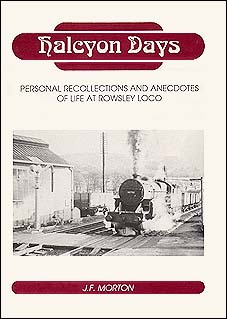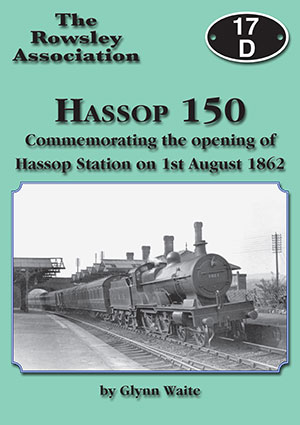
By Glynn Waite.
Published by Pynot Publishing
ISBN 978-0-9562706-7-2 : softback £8.50 (plus 1.25p postage)
Written to commemorate the 150 anniversary of the opening of Hassop station on 1st August 1862, this publication extends to 52 pages (including full colour covers), and has 70 illustrations.
Following a short introduction, there are 7 pages on how the railway came to Hassop, in part dispelling some oft repeated assumptions about the early railway scene in the area.
There are then two short sections on developments during the next 100 years – including the effect the opening of the Dore & Chinley line had on the station’s viability – and Hassop today. The main part of the book (22 pages) concentrates on staff who worked at the station, and includes 8 tables of varying lengths which cover various periods of time / grades of staff. The highest number of people employed at any one time was 11 (in the mid-1870s), but there was quite a large turnover of staff before the First World War, partly due to the fact that when juniors approached the age of 18, they often had to move elsewhere for an adult wage.
There are two tables covering passenger and goods traffic statistics between 1872 and 1922, together with various comment, and a section covering miscellaneous events in Midland Railways days taken from newspapers and other documents. Some entries are rather mundane; others relate to accidents and incidents, with some, unfortunately, involving fatalities.
The following review by Julie Bunting was published in The Peak Advertiser of 10th August 2012:
Glynn has done the Rowsley Association and all railway buffs proud with his new publication from Pynot Publishing. ‘Hassop 150’ tells in detail the story of how the railway came to Hassop, its link in the wider railway system, and its benefits to the local railway scene and beyond.
Importance is given to the old story of how a proposed alternative route through Chatsworth Park was scuppered by ducal objection, when in fact initial opposition came from an unexpected source. Yet all was resolved in the end and Hassop station came into being, just a mile from the station at Bakewell.
Statistics are sometimes astonishing, i.e. “in August 1861 it was recorded that 1,979 men and 142 horses were employed in the construction of the line between Rowsley and Buxton”. Early maps and photographs date back a century and a half, including the first known photograph of the construction of the line between Rowsley and Hassop, as well as a rare scene following the collapse of Haddon Tunnel that cost five lives.
There was more to the railway than human passengers though, from mention of a pigeon special to the comment: “.. if the activity at Bakewell on a Monday evening following the weekly cattle market was high, it had been the practice to stable them at Hassop to reduce potential congestion”.
We are shown trains going about their business under steam as well as stern uniformed staff posing on the platform, dated by their moustaches and beards, watch chains and brass buttons.
Family historians will take close interest in the section devoted to all known employees, from young teenagers to men who made the railway their career for life. One lowly native of Pilsley went on to become Traffic Superintendent of the Buenos Aires Great Southern Railway. Back on home ground, Hassop staff ranged from goods porters to checkers and clerks to platelayers … females being represented only by office cleaners. And to borrow the expression “what goes around comes around”, in 1879 a general reduction in wages “due to the state of the economy”.
How sorely local people must have complained when the Beeching Axe fell in the 1960s. Yet the Monsal Trail subsequently came into being, its tunnels reopened last year, making Hassop station perfectly sited for its new lease of life as a cycle hire centre, bookshop and café.
The following review by Dr Roger Brettle appeared in the Midland Railway Society’s Newsletter in March 2013:
This is a fascinating account of one wayside station on the Midland Railway’s Ambergate to Millers Dale main line. Glynn tells the story very well. He begins by carefully explaining how the railway came to pass through the site out in the Peak District countryside a mile north of the town of Bakewell and easily accessible from the northern part of the Chatsworth Estate. The small village of Hassop is half a mile away.
The next section discusses the work of the station, which handled declining numbers of passengers until 1942 and goods traffic until just after the Beeching Report. The route is now completely closed.
Much of the book is taken up with remarkably detailed, interesting, and painstakingly collected accounts of the men who worked there from the Station Masters and other station staff, porters, checkers, and signalmen (originally Pointsmen) from 1862 to 1908, followed by less detailed information available about staff until the final closure. A further section deals with and illustrates the permanent way staff who maintained the tracks through Hassop.
The book includes tables of passengers, passenger class receipts, goods statistics, and station expenses for the period 1872-1922. It concludes with a long list of varied and miscellaneous events at Hassop In Midland Railway days, including one or two accidents, some fatal, which give a flavour of the life at such a small outpost. The book is generously supplied with photographs at this not often chosen location, including views of the station, signal box, and goods yard over the last 150 years, and trains passing through before and after closure. A group of tickets are displayed on the back cover.
As the book shows, Hassop station these days sees considerably more visitors than it did in its days as a country station, as the Up side buildings have been adapted as a café, bookshop, and bicycle hire centre serving the popular trail, which follows the old trackbed; the yard provides a large car parking area for walkers, cyclists, and less energetic visitors. Do read this boo, and if you don’t know the site, I am sure you will find it worth a visit.
Copies of the book may be obtained from the author - Glynn Waite, 113 Green Oak Road, Totley, Sheffield. S17 4FS.
Email Glynn.Waite@btinternet.com
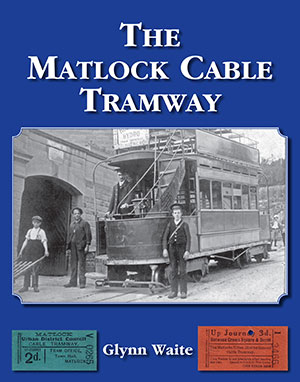
By Glynn Waite.
Published by Pynot Publishing
ISBN 978-0-9562706-5-8 : softback £19.99 from bookstores , £21.99 (mail order)
The idea of a cable tramway in Matlock goes back to the late 1860s when Job Smith, a former employee at John Smedley’s hydro, is said to have seen some early lines in San Francisco and felt that such a system would be suited to Matlock.
However, it was March 1893 before the tramway was opened, and then it only extending for half a mile, albeit over a route, that at one time made it the steepest cable tramway in the world. It is doubtful if even this modest line would have been built had it not been for the finance of George Newnes of Tit Bits fame, who originated from the area. Perhaps Newnes realised that the tramway would not be as successful as had originally been envisaged, for in 1898 he bought out his fellow shareholders and donated it to Matlock Urban District Council.
The Council took over the undertaking with great enthusiasm, even examining possible schemes for extensions, but soon realised that while it attracted many tourists during the spring and summer, it rarely covered its direct operating costs in the autumn and winter months. On top of this there were always costs of materials, especially new cables, which were changed quite frequently.
Nevertheless, until 1910 it made a profit in all but three of the years. Thereafter it started to make annual losses with the Council subsidising the undertaking from its general account. Nevertheless, it continued operating throughout the year until September 1927 despite a loss of £2,755 in 1921 when post-war inflation was at its peak, and ones in excess of 1,000 in four other years. To some extent what happened was outside the control of the Council, the cost of materials rising considerably more than it was reasonably possible to increase fares, which themselves doubled during this period.
Glynn Waite, who first took an interest in the concern when living at his birthplace of Cromford, has researched the tramway in considerable detail, in some cases dispelling information that has been repeated over the years. The book extends to 160 pages, and includes over 150 photographs and 85 other images / diagrams. There are 10 chapters.
The following are extracts from reviews:
Julie Bunting – Peak Advertiser 23rd December 2012: “Glynn Waite has done his subject proud with this painstakingly researched story”… “It would be surprising if the author has missed anything relating to this historic venture”.
The Tramway Museum Society Journal – January 2013: “This book is by far and away the most detailed account yet”… (following a listing of the contents) ... “This list probably says it all about how comprehensive the book is.”... “Highly recommended”.
Tramway Review – March 2013: “amazing that 85 years after its closure so full and attractive a history should have been produced”… “It is difficult to praise this work too highly – it is perhaps the best ‘system’ history for quite a while”.
Michael Arkle, The author of ‘Tuppence Up, Penny Down”, in an e-mail: “They say that you can't judge a book by its cover, but I think that the very attractive cover does full justice to wonderful contents. The quality and depth of the information is a testament to the depth and breadth of the research” … “I hope that Matlock appreciates just what a treasure has been produced for the town”.
Ann Andrews on her Matlock website: “The author's thorough research and the wonderful photographs makes this book stand out amongst recent Matlock publications”.
Brian Lund – Picture Postcard Monthly June 2013: “Glynn’s meticulous research takes the reader to the heart of the operation” … “lavishly illustrated” … “with copious use of plans, letters, and other source material”.
Copies of the book may be obtained from the author - Glynn Waite, 113 Green Oak Road, Totley, Sheffield. S17 4FS.
Email Glynn.Waite@btinternet.com
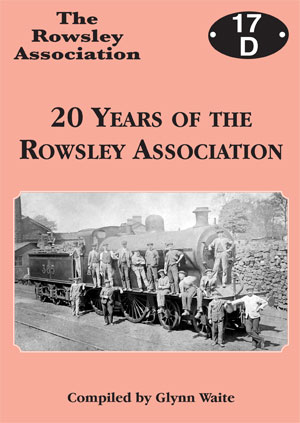
By Glynn Waite.
Published by Pynot Publishing
ISBN 978-0-956706-3-4 : softback £4.50 (plus 75p postage)
24 pages (including covers); 60 illustrations. Includes 7 pages of reminiscences, etc. similar to those contained in the Rowsley Railway Miscellany publications.
Copies of the book may be obtained from the author - Glynn Waite, 113 Green Oak Road, Totley, Sheffield. S17 4FS.
Email Glynn.Waite@btinternet.com
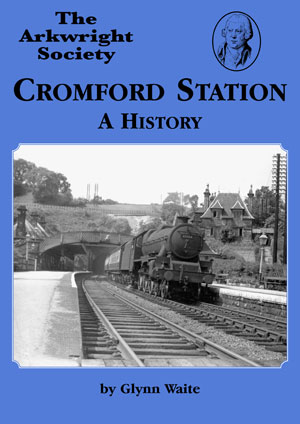
By Glynn Waite.
Published by Pynot Publishing
ISBN 978-0-9562706-0-3 : softback £11.95 (plus £1.35 postage)
Glynn Waite was born at Cromford in 1943. Over the years he has researched the history of railway operations in the area – and the Midland Railway in general – in considerable detail. Glynn had made contributions to many railway publications and was the editor of the Midland Railway Society's Journal from 1996 to 2006. In recent times he has written a number of publications about Rowsley and in 2007 the well-researched work Charles Burling : Railway Signalman of Cromford.
Glynn is a member of the Arkwright Society’s Steering Committee that has been overseeing the renovation of the Downside building at Cromford Station. All profits from the book’s sale will be donated to that project.
The book extends to 80 pages (including covers) and contains 124 illustrations and 17 tables. It comprises 12 chapters, each covering a chronological period in the station’s history. These are:
Historical Background
The MBM&MJR – Inception to Opening
The Line is Opened – The Early Years
The Line is Leased : 1852 – 1863
The Midland Spreads its Wings : 1864 – 1871
The “New” Station
Traffic Trends and Other Events : 1875 – 1913
The First World War to the Grouping : 1914 – 1922
The London, Midland & Scottish Railway : 1923 – 1947
Nationalisation : 1948 – 1994
Privatisation
The Station and its Buildings in Recent Times
In addition, there are 8 appendices, as under:
A – The Construction of the Line : Willersley Tunnel Accidents
B – 1854 Passenger Train Services
C – 1858 Passenger Train Services
D – 1863 Passenger Train Services
E – Cromford Station : Passengers, Receipts and Expenses (1872 – 1922)
F – Coaching Department Staff on Cromford Station Paybill 1855 to 1908
G – Way & Works Dept. Staff Based at Cromford Whose Services Were Dispensed With in 1908
H – Way & Works Dept. Staff Based at – or Resident at – Cromford During WW1.
Copies of the book may be obtained from the author - Glynn Waite, 113 Green Oak Road, Totley, Sheffield. S17 4FS.
Email Glynn.Waite@btinternet.com
The following review by Professor George Huxley appeared in the Midland Railway Society’s Newsletter in September 2009:
Cromford station lies upon the route of the Midland main line – now, alas, sundered – linking Derby with Manchester by way of Ambergate and Chinley. The extant station buildings have architectural merit, and, thanks to the efforts of a private owner and of the Arkwright Society, they are now in a happier state of repair. The structures are the imposing Station Master's house, the upside waiting room, and the 'new' down side station building of about 1875. There is also a handsome footbridge.
In Glynn Waite Cromford station has found a befitting chronicler. Not only is he a railwayman by profession and an accomplished historian of railways; he is also a Cromford man. This handsome publication is worthy of his careful researches. Mr Waite has contrived to include much instructive detail in the story he tells. There are clear plans and maps and some finely evocative illustrations. A few examples will indicate that his is a significant contribution to the local history of the Derwent Valley.
The original line from Amber Gate (thus spelled) to Rowsley was the work of the grandly named Manchester, Buxton, Matlock, and Midland Junction Railway. The provisional directors included both George Hudson and Joseph Paxton. The Midland's determination to reach Manchester is emphasized, and the potential threat from the L&NWR owing to joint ownership of the MBM&MJR is explained. The Midland's strategy even allowed for the construction of a new line northwards from Wirksworth to near Rowsley on an alignment to the west of Matlock Bath. There are excellent discussions of train times up to the present and of fares and passenger numbers reflecting the vicissitudes of the British economy. Signalling is not neglected - there is, for example, an account of working hours at Cromford Sidings' box. Attention is drawn, in an appendix, to accidents during the making of Willersley Tunnel. Other hazards such as landslips are recorded. We learn incidentally about a monster potato grown in 1908 by the Cromford Station Master and are alerted to the determination of both the Midland and the LMS to promote excursion traffic. Mr Waite, indeed, is constantly aware of social history. He also records evidence of administrative barbarism; in BR times a canopy was removed from the front of the main station building though the structure had been listed (p.56). Losses of Cromford railwaymen who went to war in 1914 to 1918 are respectfully recorded. There are delightful photographs of trains passing Cromford, some hauled by Compound 4-4-0s; this aged reviewer admires most of all the picture of a 3F 0-6-0 with a Down pickup goods passing the two upper-quadrant Distant signal arms sharing a post at the south end of the Down platform; it brought back happy memories of the LMS before 1939.
Members of the Society will find joy in this superb work. Warmly commended.
The following review by Julie Bunting was published originally in The Peak Advertiser of 10th August 2009:
One does not have to be a railway buff to recognise that Cromford station is a true gem - in 1970 the setting provided memorable opening scenes for the film The Virgin and the Gypsy, based on the novel by D.H. Lawrence.
Fortunately, this photogenic station with its unique Grade 2 listed buildings has good friends, including a private owner and The Arkwright Society, whose ongoing Station Project will benefit from all profits from this new publication by the highly regarded railway historian, Glynn Waite.
The story involves endless aspects of local life and the changes seen since Cromford station was opened 160 years ago by the Manchester, Buxton, Matlock & Midland Junction Railway. This was an era of fierce competitiveness between railway companies, giving rise to various plans for a line along the Wye Valley to Buxton via Rowsley and Bakewell. In 1869, the Midland Railway proposed a railway from Wirksworth to Rowsley, running some distance west of Cromford station, but this became unncessary when two years later the Midland became sole owner of the existing line, enabling them to achieve the Buxton goal.
Day excursionists (Matlock Bath was the next station down the line) and merchandise from John Smedley's mill at Lea Bridge were to contribute to the financial success of Cromford station. In 1872 – when the Midland 'startled its competitors by allowing 3rd Class penny-a-mile passengers on all its trains' – over 24,000 passengers were booked in, not to mention £226 from 'Parcels, Horses, Dogs, etc.' Passengers peaked at 35,960 In 1901 and passenger traffic eventually survived the 'Beeching Axe' in modern times.
Cromford Station - A History is generously illustrated with photographs, tickets, timetables and fascinating local news cuttings. Written by Glynn Waite and published by Pynot Publishing priced £11.95, the book is in stock or available to order through local outlets.
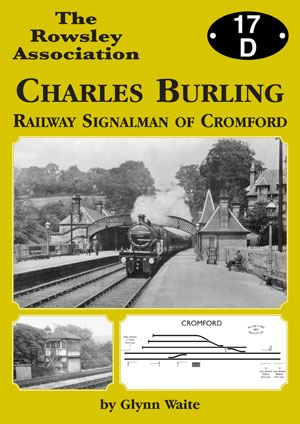
By Glynn Waite.
Published by Pynot Publishing
ISBN 978-0-9552251-4-7 : softback £9.99 (plus £1.25 postage)
Glynn Waite was born at Cromford in 1943. Over the years he has researched the history of railway operations in the area – and the Midland Railway in general – in considerable detail. Glynn had made contributions to many railway publications. He was the co-author of Rowsley : A Rural Railway Centre, the editor of Rowsley Railway Miscellany (see below) and the editor of the Midland Railway Society's Journal from 1996 to 2006.
Charles Burling – a career railway man – joined the Midland Railway as a porter at Elsecar & Hoyland station, near Barnsley, in 1900. He came to Cromford as a signalman in 1911 and lived in the village for the rest of his life. After working in several other signal boxes in the district, he became a signalman at Matlock Bath in 1938 and retired from that position in 1947.
During certain periods of his life, Charles recorded details of his career and the local railway scene in notebooks. The publication is primarily based on information contained in two of these books. His railway career is covered in some detail, as is the local railway scene – and to a lesser degree, the national one – from 1912 to 1917. This has been supplemented by notes and appendices which are the result of research into some of the events recorded in the notebooks. The publication contains 68 pages and includes almost 100 illustrations.
The main text comprises 3 sections:-
1. Charles’ Railway Career
2. The Local Railway Scene Around Cromford 1912 to 1917
3. General Circulars, Notices and Other Miscellaneous Information 1912 to 1917.
There are 19 appendices, as under:-
A – Signalling Arrangements and Developments at Cromford.
B – Extracts from the Settlement Relating to ‘Rates of Wages, Hours of Labour and Conditions of Service’ of Midland Railway Signalmen Introduced on 1st July 1912.
C – Summary of Settlement Relating to Midland Railway Signalling Grades 13th February 1914.
D – Alterations to Signal Box Classification and Signalmen’s Pay 1920 to 1922.
E – A Willersley Tunnel Incident – The Death of William Boden on Monday 18th November 1912.
F – Trains Passing Cromford Sidings Signal Box July, August and September 1914.
G – Passenger Excursion Trains Timed to Pass Cromford Sidings Signal Box Between Monday 13th and Sunday 19th July 1914.
H – Trains Calling at Cromford Station July, August and September 1914.
I – The Cromford & District Branch of the Amalgamated Society of Railway Servants.
J – Members of the Cromford & District Branch of the ASRS During its First year – 1897.
K – Derailment of Goods Train at Church Lane Crossing, Darley Dale, on Friday 19th September 1913.
L – Cromford Station Masters.
M – The Death of Signal Fitter Frederick Eley in Dove Holes Tunnel, Friday 31st October 1913.
N – The Death of Ganger Samuel Smith in Milford Tunnel, Tuesday 16th December 1913.
O – The Tragic Death of Porter Joseph Pickering at Cromford Station on 21st February 1914.
P – The Death of Junior Porter Donald Preece Near Church Lane Crossing, Friday 19th March 1915.
Q – Fatal Accident to Stone Merchant John Sims Near Whatstandwell on Saturday 5th June 1915.
R – A Cycling Accident on Cromford Hill Involving Shunter John Ward of Matlock – 21st June 1915.
S – The Deaths of Two Passengers at Ambergate Station.
Copies of the book may be obtained from the author - Glynn Waite, 113 Green Oak Road, Totley, Sheffield. S17 4FS.
Email Glynn.Waite@btinternet.com
The following review is by Dave Harris, Secretary of the Midland Railway Society and co-ordinator of the Midland Railway Study Centre at Derby.
Many railwaymen keep diaries, usually to enable them to check that their pay packet is correct. Many, especially relief signalmen, go further, using a diary or notebook to record their work, often in quite intricate detail. What makes Charles Burling’s notebooks special - quite apart from their survival as a kind of family heirloom - is that Charles’ son Frank was the Godfather of a certain Glynn Waite.
Unfortunately for all concerned, it was only after Frank’s death that Glynn learned that his father was a signalman on the Midland Railway. Had the opportunity arisen for Glynn to talk to Frank about his father’s life as a railwayman, this would have been an entirely different publication.
As it is, it’s a shining example of extensive and meticulous research - with a bit of detective work thrown in. Rather than simply reproduce Charles’ notebooks in facsimile, Glynn has chosen to analyse every detail they contain and present the reader with a context to the entries. Drawing on his own extensive knowledge of the railway on which Charles worked, as well as the collections of several libraries and institutions, Glynn has created a wide-ranging glimpse into the life of a railwayman in the early part of the Twentieth Century.
Charles Burling started his railway career at the turn of the century, and though his first posting was Wombwell near Barnsley, he very soon began his long association with the Cromford area of Derbyshire. This was the rural mainline railway at its most typical and, with Glynn’s help, his notebooks paint a vivid picture of a way of life that we can only wonder at.
The notebooks record what was happening around him, from mundane personal details to wider world events. In a time and place where there were few strangers, the lives (and, sadly, deaths) of many people are chronicled. Of course the Great War was to change everything, and the notebooks reflect how even in the Derwent Valley, so far from the trenches, life was affected.
Meanwhile, Charles was a union man, and so it is inevitable that his notebooks refer to the issues facing railwaymen of the period. Again, Glynn has worked hard to provide the reader with the background to Charles’ entries - along the way providing an explanation of the signlabox classification system and how this developed.
As far as the intricacies of his job as a signalman are concerned, the notebooks record only the few out-of-course happenings such as carriage doors being observed un-latched or signal lamps out. Recognising a need to redress the balance for the reader, Glynn has put together a wealth of detail concerning the operation of the signal box at Cromford Sidings and the passing trains Charles would have looked after.
Reflecting the almost scatter-shot nature of the subject matter within the notebooks, Glynn has separated the detail relating to Charles’s career from events on the wider railway around him, placing them in separate sections. Making use of no less than 19 appendices, which provide background detail on incidents mentioned only in passing in the notebooks, he has managed to squeeze an inordinate amount of information into the 69 pages. Employing an A4 format with soft covers that will be familiar to members of the Midland Railway Society, the book is copiously illustrated with little or no redundant space.
This is a publication that will appeal to anyone with an interest in social history, whether specific to the Derbyshire area, the Midland Railway and its men, or even the wider subject of the embryonic union movement.
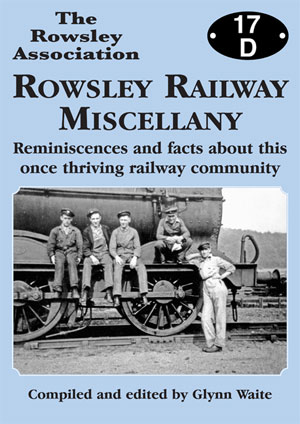
Compiled and edited by Glynn Waite.
Published by Pynot Publishing
ISBN 978-0-9552251-1-6 : softback £7.50 (plus £1 postage)
Glynn Waite was the last Chief Clerk at Rowsley Shed. He has researched the history of railway operations at Rowsley - and the Midland Railway in general - in considerable detail. Glynn was the co-author of 'Rowsley : A Rural Railway Centre' and has written / edited all of the Rowsley Association publications. He was the editor of the Midland Railway Society's Journal from 1996 to 2006.
This publication consists of extracts from the Association's Newsletters that have appeared regularly since 1995 and covers 35 different subjects. See also home page, Newsletter extracts and Rowsley Railway Miscallany – 2.
Copies of the book may be obtained from the author for £8.50 including postage - Glynn Waite, 113 Green Oak Road, Totley, Sheffield. S17 4FS.
Email Glynn.Waite@btinternet.com
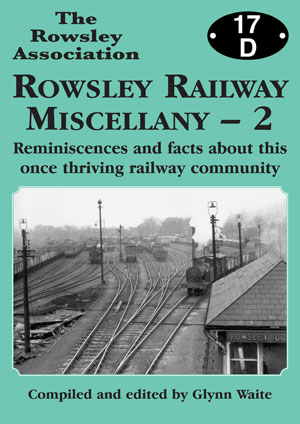
Compiled and edited by Glynn Waite.
Published by Pynot Publishing
ISBN 978-0-9552251-9-2 : softback £7.95 (plus £1 postage)
Glynn Waite was the last Chief Clerk at Rowsley Shed. He has researched the history of railway operations at Rowsley - and the Midland Railway in general - in considerable detail. Glynn was the co-author of 'Rowsley : A Rural Railway Centre' and has written / edited all of the Rowsley Association publications. He was the editor of the Midland Railway Society's Journal from 1996 to 2006.
This publication comprised further extracts from the Association's Newsletters that have appeared regularly since 1995 and covers 30 different subjects, some extending to 3 or more pages, while others just give brief detail, albeit covering the topic fully. Contains 62 illustrations. See also home page, Newsletter extracts and original Rowsley Railway Miscallany.
Copies of the book may be obtained from the author for £8.95 including postage - Glynn Waite, 113 Green Oak Road, Totley, Sheffield. S17 4FS.
Email Glynn.Waite@btinternet.com
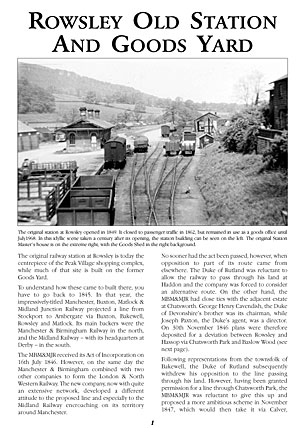 |
Compiled by Glynn Waite. Rowsley Old Station and Goods Yard is an 8 page illustrated brochure which examines the history of the complex from the 1840s until closure in 1968 – part of which is now the centrepiece of the Peak Village Shopping Centre. Copies cost £1.50 (plus 50p p&p – but post free if ordered with another Rowsley Association publication). Rowsley’s Engine Sheds records their historical development from 1849 to the present day. The publication is in a similar format to the ‘Old Station’ brochure, but extends to 12 pages. Copies cost £2.00 (plus 50p p&p – but post free if ordered with another Rowsley Association publication). Copies may be obtained from Glynn Waite, 113 Green Oak Road, Totley, Sheffield. S17 4FS. |
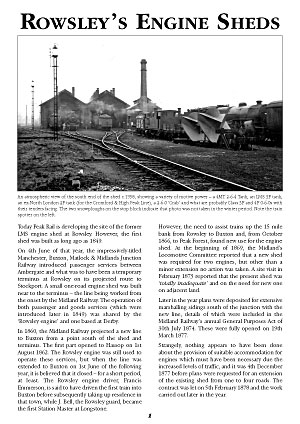 |
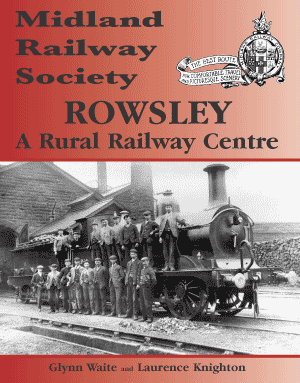
by Glynn Waite and Laurence Knighton.
ISBN 0-9537486-2-6 : softback £6.50: hardback £8.50 (post free!)
Glynn Waite and Laurence Knighton are respectively Chairman and Vice Chairman of the Midland Railway Society. They were both born locally and have studied the development of railways in the Rowsley area over many years - in fact, Glynn was the Chief Clerk at the engine shed when it closed in 1966. They have used material from their extensive archives to produce this 128-page detailed history of railways in the Rowsley and Darley Dale area from their origins in the 1840s to the present day. The book contains 250 illustrations, many of which have not been previously published. Details of staff, train services and other features that do not fit easily into a chronological account of the area, are contained in 23 appendices. One of these deals with special trains and special passengers, which were regular features 100 years ago when Royal Trains brought King Edward VII and Queen Alexandra to Rowsley en route to Chatsworth for the famous house parties.
That, however, was the 'glamour' side of Rowsley, for until the mid-60s there was also a large engine shed and marshalling yard. The book tells how the rural peace was disturbed by the coming of the railway in 1849 and how, from the 1870s, it became by far the biggest employer in the area. At its peak just after the Second World War there were approximately 550 staff based at Rowsley. It also shows how quickly this dedicated workforce was disbanded and the railway closed down. In recent years part of the line has re-opened and there are plans for extensions. But one thing is certain - we will never again see the concentration of activities and labour that were so common on the railways of yesteryear, and which are described in some detail in the book.
Copies of the book can be obtained from the authors post free - Glynn Waite, 113 Green Oak Road, Totley, Sheffield. S17 4FS. Email Glynn.Waite@btinternet.com
The following review is by Julie Bunting, and was published originally in The Peak Advertiser.
ROWSLEY - A RURAL RAILWAY CENTRE
by Glynn Waite and Laurence Knighton
Describing themselves as career railwaymen, Glynn Waite and Laurence Knighton are, respectively, Chairman and Vice Chairman of the Midland Railway Society, publishers of this highly informative book. Both authors have also contributed to the Rowsley Association's magnificent collection of railway photographs, used liberally in Rowsley - A Rural Railway Centre , a book dedicated to 'the railwaymen and railwaywomen of Rowsley who created a spirit that refuses to die'.
At its commercial peak, just after the Second World War, 550 railway staff were employed at Rowsley and many readers will remember the once bustling depot which closed in the 1960s. It is impossible to separate the history of Rowsley from the railway and, remarkably, around 130 people still get together for an annual commemorative reunion.
It was the great George Stephenson who 160 years ago surveyed a route on behalf of the Manchester, Buxton, Matlock & Midlands Junction Railway. Running south of Buxton it was to join the Midland Railway at Ambergate via 'the Valleys of the Wye and Derwent to or near Ashford, Bakewell, Chatsworth, Winster, Matlock, and Cromford'. Importantly, the Nottinghamshire and Derbyshire coalfields would be linked to the industrial north via Rowsley.
By 1861 nearly 2,000 men and 140 horses were employed in construction of the line; in the event it was the Midland which achieved the goal of reaching Manchester. Modifications had to be made to the original prospectus, partly to allow for differing ducal opinions which almost denied Bakewell a mainline connection. Joseph Paxton, a director of the MBM & MJR, designed Rowsley's station building, now the attractive centrepiece of Peak Village.
In June 1863 the entire line between Rowsley and Buxton was open to both goods and passenger traffic. The Rowsley depot received valuable revenue from the despatch of local milk churns; textiles from Calver Mills reached the goods yard by road, and stone merchants set up outlets for the easy export of Peakland stone and lime.
Rowsley was the station for Chatsworth and welcomed dignitaries such as Mr & Mrs Gladstone, the Russian Ambassador and members of the British and foreign royal families. In 1908 three hundred MPs disembarked from 'specials' at Rowsley for the funeral of the Duke of Devonshire. Waite and Knighton have tracked down a ticket of 1895 for the Prince of Wales' dog which arrived by train from Sandringham, a telegram relating to the conveyance of a Daimler to the Duke of Devonshire in 1912 and, more prosaically, a memorandum from a signalman to the Station Master - working less than 200 yards away - reporting that 'The Clock in this Box is out of order & will not go'. On one occasion the Station Master was admonished over the one-minute delay of a passenger train!
Absolutely everything had to be documented, providing so many fascinating diversions that this book extends far beyond its inestimable worth to railway enthusiasts. The authors have brought together years of research to produce a permanent record which will be the envy of lost railway centres around the country.
The following review appeared in the Journal of the Historical Model Railway Society.
Rowsley was one of those mainline railway outlets like Woodford and Hinton where the town attached was small but the railway presence was big. It was the principal freight yard and locomotive depot on the much lamented Midland Railway main line through the Peak District of Derbyshire from Ambergate to Chinley. Its strategic location on a solitary mainline carrying heavy freight traffic had only the Buxton branch and the legendary Cromford & High Peak line to divert attention, if it were possible to divert attention from such a magnificent railway in spectacular territory with spectacular engineering and spectacular operation.
Much of the text of this book is devoted to the history of the line and particularly to Rowsley itself; from planning stage to its untimely closure in 1968. Each phase is well illustrated with photographs of the period. Numerous diagrams and reproductions of timetables, engine and crew rosters and tabulations of personnel bring an intensely human aspect to the publication, something that is missing in many railway history books. There are many reproductions of such often ignored but vital railway subjects as tickets, parcel labels, correspondence, letterheads, bills and posters, all of which refer to the station, locomotive depot or Sidings.
The greatest impact this book has are the many photographs of railwaymen (and railwaywomen). Often ignored, it is unlikely that such a substantial assembly has been seen before in a book about a single town. The authors deserve every credit for locating such a collection of photographs. One looks at the published rosters of enginemen and shed staff and there they are, almost in person. The authors dedicate the book to the railwaymen and women of Rowsley; their memory has been magnificently. preserved.
